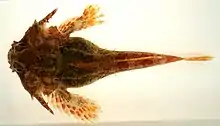Enophrys
Enophrys is a genus of marine ray-finned fishes belonging to the family Cottidae, the typical sculpins. These fishes are found in the northern and eastern Pacific Ocean.
| Enophrys | |
|---|---|
_196mm.jpg.webp) | |
| Buffalo Sculpin (E. bison) | |
 | |
| Antlered Sculpin (E. diceraus) | |
| Scientific classification | |
| Domain: | Eukaryota |
| Kingdom: | Animalia |
| Phylum: | Chordata |
| Class: | Actinopterygii |
| Order: | Scorpaeniformes |
| Family: | Cottidae |
| Subfamily: | Cottinae |
| Genus: | Enophrys Swainson, 1839 |
| Type species | |
| Cottus claviger | |
| Synonyms[1] | |
Taxonomy
Enophrys was first proposed as a monospecific genus in 1839 by the English zoologist William John Swainson with its only and type species being Cottus claviger.[1] This species had been described in 1839 by the French zoologist Georges Cuvier from Kamchatka but it was later determined to be a synonym of Cottus diceraus, originally described by Peter Simon Pallas in 1787, also from Kamchatka.[2] The 5th edition of Fishes of the World classifies this genus within the subfamily Cottinae of the family Cottidae,[3] however, other authors classify the genus within the subfamily Myoxocephalinae of the family Psychrolutidae,[1] although others place the subfamily Myoxocephalinae within the Cottidae.[4]
Etymology
Enophrys prefixes phrys, meaning "brow", with en, ning "very", presumed to be a reference to the thick orbital ridge of the type species.[5]
Species
Enophrys contains 4 recognized species within it:[6]
- Enophrys bison (Girard, 1854) (Buffalo sculpin)
- Enophrys diceraus (Pallas, 1787) (Antlered sculpin)
- Enophrys lucasi (D. S. Jordan & C. H. Gilbert, 1898) (Leister sculpin)
- Enophrys taurina C. H. Gilbert, 1914 (Bull sculpin)
Characteristics
Enophrys sculpins share the possession of plates along their lateral lines and some species have prickly scales underneath the lateral line. They also have a very long, sharp spine on the upper preoperculum and sharp spines on the nose.[7] The bull sculpin is the smallest species with a maximum recorded total length of 17 cm (6.7 in) while the largest species is the buffalo sculpin which reaches a maximum publsihed total length of 37 cm (15 in).[6]
Distribution
Enophrys sculpins are only found in the northern and Eastern Pacific Oceans from the Sea of Japan to California.[6]
References
- Eschmeyer, William N.; Fricke, Ron & van der Laan, Richard (eds.). "Genera in the family Myoxocephalinae". Catalog of Fishes. California Academy of Sciences. Retrieved 22 January 2023.
- Eschmeyer, William N.; Fricke, Ron & van der Laan, Richard (eds.). "Species in the genus Enophrys". Catalog of Fishes. California Academy of Sciences. Retrieved 23 January 2023.
- J. S. Nelson; T. C. Grande; M. V. H. Wilson (2016). Fishes of the World (5th ed.). Wiley. pp. 467–495. ISBN 978-1-118-34233-6.
- Olga A. Radchenko; Irina N. Moreva; Anna V. Petrovskaya (2021). "The subfamily Myoxocephalinae of cottid fishes (Cottidae): Genetic divergence and phylogenetic relationships". Journal of Fish Biology. 99: 1857–1868. doi:10.1111/jfb.14886.
- Christopher Scharpf & Kenneth J. Lazara, eds. (22 October 2022). "Order Perciformes: Suborder Cottoidea: Infraorder Cottales: Family Cottidae (Sculpins)". The ETYFish Project Fish Name Etymology Database. Christopher Scharpf and Kenneth J. Lazara. Retrieved 23 January 2023.
- Froese, Rainer and Pauly, Daniel, eds. (2022). Species of Enophrys in FishBase. August 2022 version.
- Matthew L. Knope (2013). "Phylogenetics of the marine sculpins (Teleostei: Cottidae) of the North American Pacific Coast". Molecular Phylogenetics and Evolution. 66: 341–349. doi:10.1016/j.ympev.2012.10.008.